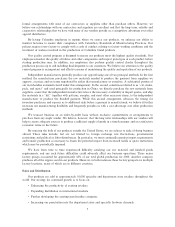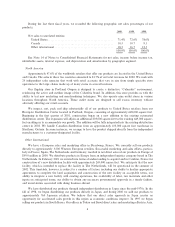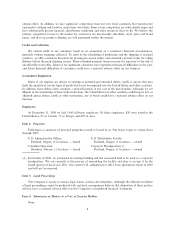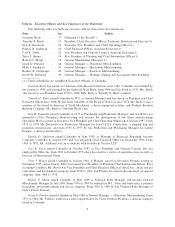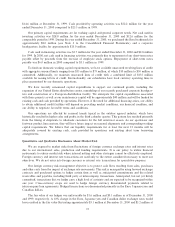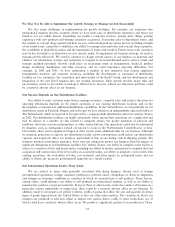Columbia Sportswear 2000 Annual Report Download - page 26
Download and view the complete annual report
Please find page 26 of the 2000 Columbia Sportswear annual report below. You can navigate through the pages in the report by either clicking on the pages listed below, or by using the keyword search tool below to find specific information within the annual report.Interest Expense: Interest expense decreased by 12.1% in 2000 from the comparable period in 1999. The
decrease was primarily attributable to our increased cash position during the Ñrst, second and fourth quarters
of 2000 as compared to the same periods in 1999 and our decreased borrowings during the third quarter of
2000 compared to third quarter of 1999.
Income Tax Expense: The provision for income taxes was $33.5 million and $22.2 million for 2000 and
1999, respectively. The provision for income taxes, as a percentage of pre-tax income was 36.4% and 40.2% for
2000 and 1999, respectively. The decrease in tax rates, which may not be replicated in future periods, was due
primarily to the utilization of foreign tax credits.
Year Ended December 31, 1999 Compared to Year Ended December 31,1998
Net sales: Net sales increased 10.1% to $470.5 million in 1999 from $427.3 million in 1998. The increase
in net sales was due primarily to growth in our international business. Domestic sales increased 1.7% to
$341.6 million in 1999 from $335.9 million in 1998. Net international sales, excluding Canada, increased
49.2% to $78.5 million in 1999 from $52.6 million in 1998. The increase in net international sales was due
primarily to increases in European and Japanese direct sales, which increased $14.2 million or 52.1% and
$10.4 million or 133.8%, respectively. Unit sales generated these increases for both Europe and Japan across
all product lines. Canadian sales increased 30.0% to $50.4 million in 1999 from $38.8 million in 1998. This
Canadian sales growth was due to increased sales unit volume across outerwear, sportswear and footwear
product categories.
Gross ProÑt: Gross proÑt as a percentage of net sales was 44.8% and 43.7% for 1999 and 1998
respectively. This increase of 110 basis point in gross margin was due to a combination of factors. These
include an increase in higher margin international sales, which increased to 16.7% of net sales in 1999 from
12.3% in 1998 as a percent of net sales, minimal oÅ-price sales for the year with strong margins on those
products which were discounted, and favorable pricing on fall 1999 production. The increase in the gross
margin was also attributable to the continued emphasis on inventory management, which resulted to fewer
markdowns and closeouts as well as manufacturing eÇciencies.
Selling, General and Administrative Expense: Selling, general, and administrative expense increased
15.1% to $150.8 million in 1999 from $131.0 million for 1998. As a percentage of sales, selling, general, and
administrative expenses increased to 32.1% in 1999 from 30.7% in 1998. The increase was primarily due to an
additional $5.0 million in depreciation expense as capital projects including the new distribution center and
enterprise wide information system were capitalized in 1998 and an entire year of depreciation was recorded in
1999. Additionally, we incurred $1.5 million in expenses relating to the announced closure of our only
manufacturing facility in the third quarter of 1999. Additional drivers of selling, general, and administrative
expenses included variable expenses relating to the higher sales for the year and the continued expansion of
our other international operations.
Interest Expense: Interest expense increased by 18.3% in 1999 from the comparable period in 1998. The
increase was attributable to Ñnancing for capital projects and working capital needed to fund the growth in
sales activity for year ended December 31, 1999.
Income Tax Expense: The provision for income taxes increased due to growth in income before income
tax and the increase of our eÅective tax rate from 36.8% in 1998 to 40.2% in 1999. The increase in our eÅective
tax rate was due to the recognition of a non-recurring, non-cash beneÑt of approximately $2 million in the Ñrst
quarter of 1998. This beneÑt was a result of the termination of our ""S'' corporation status and was recognized
in order to record deferred income taxes for the tax eÅect of cumulative temporary diÅerences between
Ñnancial and tax reporting. See Notes 2 and 9 to the Consolidated Financial Statements.
Liquidity and Capital Resources
We Ñnanced our operations in the year ended December 31, 2000 primarily through cash provided by
operating activities. At December 31, 2000, we had total cash equivalents of $35.5 million compared to
14



